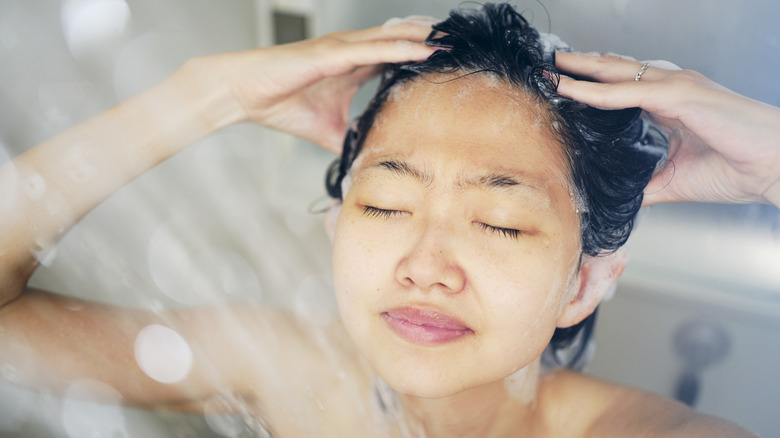Our Best Tips For Combatting Static Hair This Winter
During the winter months, it can sometimes seem as if your hair has mind of its own – refusing to lay flat, clinging to fabrics, and frizzing like crazy despite how much you comb it down. That's all thanks to a fun thing we call static. "Static hair occurs when your hair builds up an electric charge, meaning it has gained some extra electrons thanks to friction or a change in humidity," Bridget Brager, a celebrity hairstylist and T3 Stylist Ambassador, explained to Good Housekeeping. Similar to how magnets work, these bonus electrons give your tresses a positive charge that makes them unable to stick together, thus creating frizz.
Although static hair can be a year-round thing, it's often worse in the winter months because of the chilly air. As Holly Dear, hair artist and salon owner, told Prose, "[Static is] also caused by exposure to wind and drier weather. The pH balance is off due to dehydration and the breaking down of the cuticle." And because dry, damaged hair has a negative charge, when each strand comes into contact with the other, it creates friction and fly aways.
But don't fret, because you don't have to be a victim of super static-y hair every time scarf season rolls around. There are several ways you can prevent your locks turning into a charged-up mess without having to cover it under a hat.
Keep your hair moisturized with the right products
Now that we've gone over how static loves dry hair, one of the easiest steps you can take to preventing it is by keeping your tresses nice and hydrated. How much moisture your hairs needs will be unique to you, so it may take some trial and error to get the balance right. But once you do, it'll be so worth it. "By using the right hair-care products, your scalp keeps its natural balance of moisture and oils, and your hair shaft stays flexible and nourished," Deycke Heidorn, a celebrity hair stylist, explained to Self.
If your hair needs a little extra boost of hydration, or has a tendency to soak moisture like a sponge, you may also want to look into leave-in conditioners. "The moisture in the product will eliminate the electric charge that causes static, and that moisture and oil will allow your hair to become manageable again," Heidorn shared. Gina Rivera, celebrity stylist and Phenix Salon Suites founder, even recommended to Prose applying a deep conditioning treatment to static prone hair once a week. Equally, a leave-in conditioner can even be applied to your tresses while you're out, as it will also help smooth static hair down.
Change up your pillow and hair towels
One of the easiest ways to prevent static is to switch to a microfiber towel. "Cotton can be harsh on the hair. Microfiber towels are so helpful because they lay the cuticle flat and absorb a ton of water which helps in drying the hair," Bridget Brager told Good Housekeeping.
But it's not just your hair towel that could probably do with an upgrade. Pillowcases made of some more common materials, such as cotton or something more porous like wool, can actually snag the hair while you're sleeping. That's where switching to a silk pillowcase can be a game-changer. Unlike those other fabrics, its fibers won't yank at your strands. It also doesn't attract moisture, meaning, it won't dry out your hair. "Imagine your hair laying upon smooth-as-ice silk versus laying on a pair of denim jeans and well, there's your solution," Gregory Patterson, a celebrity hairstylist, told Good Housekeeping. Although all hair types can get static-y from time to time, damaged hair is particularly susceptible to it. And sleeping on a silk pillowcase is one way to help minimize that damage — and therefore minimize static at the same time.
And try silk lined hats or scarves to reduce friction
During the winter, we're constantly putting our hair into contact with materials like wool to keep warm. However, while animal fibers are great at keeping our head warm, they can cause unnecessary friction and breakage for our hair. That's why accessories lined with or made from satin are best if you're trying to combat static, because it won't pull on your strands in the same way. "It's all about minimizing the friction points. The more your hair rubs together on or with something rough, [the more] electric charges are produced and then, of course, static," Gregory Patterson told Good Housekeeping.
Of course, it's important to bundle up in the winter months to stay warm and we'd never recommend ditching layers of clothing, as that could affect your health. But one way to stay warm but also prevent static hair is to try opting for a slightly looser fitting hat. That's because the further away these accessories are from your locks, the less likely they are to result in an electric charge. Brands like "Shark Tank"'s KIN apparel even sells hoodies lined with satin to keep hair looking and feeling its best. If you absolutely cannot avoid wearing a wool hat, lather up your hair with a good quality oil or moisturizer, and wrap it in a scarf before putting the hat on top.
Try a natural bristle brush (and stay away from plastic)
Along with adding more moisture to your routine, switching up your hair tools can make all the difference when combatting frizz. As good as a hard plastic brush can be at detangling, they can be pretty harsh on your strands. And if you're already dealing with dry or damaged hair, this can make static even worse.
Instead, consider swapping out your synthetic brushes for ones made with natural materials. "Natural bristle brushes are best to use in hair that is prone to static," hair artist Holly Dear explained to Prose. " This helps create natural oil from the scalp and doesn't hold the electric charge that when rubbed against the hair can create static." Dear added that boar bristle brushes have so many benefits when it comes to hair health, which will all help prevent static locks. It may be a particularly good idea to keep a natural bristle brush in your bag. That way, you can use it while you're out and about and your hair's showing signs of static to smooth it down again.
Try a hairstyle that can't succumb to static so easily
As some of the tips on our list may take a little while to get your hair in anti-static shape (bringing back moisture, for example, could take a few weeks) there's something you can do in the meantime. Try a new look. Static is most likely to crop up when we're putting things like hats over a hairstyle where your hair is down. That's because your tresses are free to stand up all over the place without being confined. Therefore, if you're really struggling to keep your hair tamed, it's worth trying a style where it's much harder for it to have a mind of its own.
A slicked back ponytail is one way to combat unruly locks, as gelled back locks at the roots will stay in place thanks to the product. You could also try cute French plaited pigtails, as your hair will be more locked into position than if it were down. For textured hair, braids or buns may be a solid option for when static just won't stay away. There are plenty of stylish hat hairstyles out there though, so it's all about finding out what works for your length and texture while keeping pesky static down.





